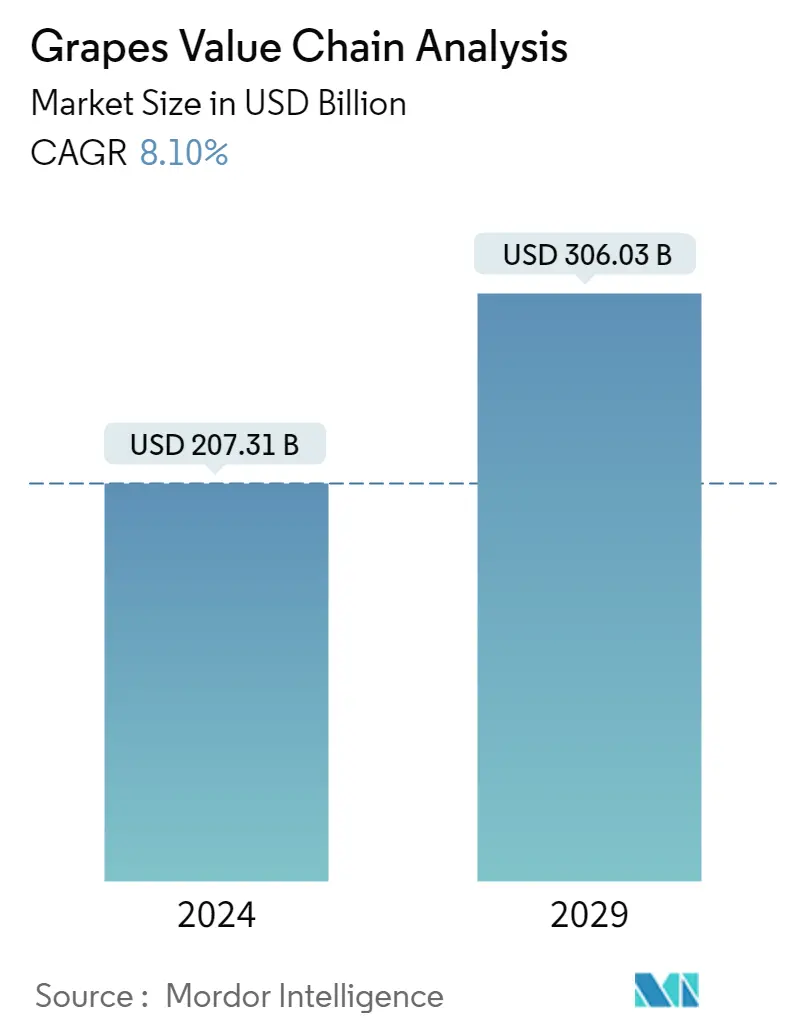Market Size of Grapes Value Chain Analysis

| Study Period | 2019 - 2029 |
| Market Size (2024) | USD 207.31 Billion |
| Market Size (2029) | USD 306.03 Billion |
| CAGR (2024 - 2029) | 8.10 % |
| Fastest Growing Market | Asia-Pacific |
| Largest Market | Asia-Pacific |
Major Players*Disclaimer: Major Players sorted in no particular order |
Grapes Value Chain Analysis Market Analysis
The Grapes Market size is estimated at USD 207.31 billion in 2024, and is expected to reach USD 306.03 billion by 2029, growing at a CAGR of 8.10% during the forecast period (2024-2029).
- Grapes are one of the largest fruit crops, with approximately 6,729,198 hectares of area harvested worldwide in 2021. According to a United States Department of Agriculture report, global table grape production in 2021 reached about 25.5 million metric tons (MMT). Table grapes and wine grapes are the two major types of grapes grown worldwide, out of which table grapes are freshly consumable.
- The Farmers are the primary stakeholder in the grape value chain, and they involve in the process of production of grapes. Farmers incur various costs, including seed, labor, tractor, and transportation. Aggregators/farmer co-operatives are the stakeholders in the grape value chain next to farmers.
- After aggregators/farmer co-operatives exporters come into the role, the major exporters of grapes are the United States, Peru, Chile, and the Netherlands. The costs incurred by exporters include labor, transportation, overheads, bulk packaging, fertilizer, crop protection, and insurance charges. Exporters also pay insurance for the value of the commodity and vehicle they are exporting to safeguard the capital invested, despite the adverse situations during transport from one port to another.
- Moving forward in the chain, importers, and wholesalers come next to exporters. And the final stakeholders in the grape value chain are retailers. Costs incurred by the retailers include transportation, overheads, and packaging costs.
- Developing new varieties of fresh grapes requires significant investment and experimentation. The R&D activities and launching of. It produces grapes varieties tiesfreshmanainly being carried out around the globe by public and private firms for future development in the grape market. For instance, recently, Embrapa, the Brazilian Agricultural Research Corporation, Semiárido unveiled the first table grape variety BRS Tainá to be bred exclusively for production in the northeast of Brazil. BRS Tainá is a white seedless variety with a 'neutral and pleasant flavor,' developed to suit the growing conditions in the Sào Francisco Valley. It is also a fast-growing, vigorous variety with an average yield of 25 tonnes per hectare per production cycle,' medium-sized bunches weighing around 270g and measuring 15cm x 10cm.
Grapes Value Chain Analysis Industry Segmentation
A grape is a fruit, botanically a berry, of the deciduous woody vines of the flowering plant genus Vitis. Grapes are a non-climacteric type of fruit, generally occurring in clusters.
The Grapes Value Chain Analysis Market Report offers an Overview, Price Markups, Stakeholders, and Issues and Challenges of the value chain and supply chain of Grapes.
Grapes Value Chain Analysis Size Summary
The grape industry is a significant segment of the global agricultural market, with grapes being one of the largest fruit crops cultivated worldwide. The value chain of grapes involves multiple stakeholders, starting from farmers who bear the initial costs of production, including seeds, labor, and transportation. Following farmers, aggregators or farmer cooperatives play a crucial role in the supply chain, which is then followed by exporters from major producing countries like the United States, Peru, Chile, and the Netherlands. These exporters incur additional costs such as labor, transportation, and packaging. The chain continues with importers and wholesalers, culminating with retailers who also bear costs related to transportation and packaging. The development of new grape varieties through research and development activities is essential for meeting the increasing consumer demand, driven by the health benefits associated with grape consumption.
The market for grapes is poised for substantial growth, fueled by rising health consciousness and the increasing popularity of grapes as a nutritious food option. Countries like China, Turkey, Brazil, and the United States are leading producers, with China being the largest globally. The expansion of the wine industry, particularly in China, further boosts grape production, as grapes are the primary ingredient in wine manufacturing. Investments in production facilities and the adoption of new cultivation techniques are contributing to increased grape yields. The market is also witnessing technological advancements, such as the integration of blockchain for traceability in exports, which enhances the efficiency and security of the grape value chain. As consumer awareness and demand continue to rise, the grape market is expected to experience robust growth during the forecast period.
Grapes Value Chain Analysis Market Size - Table of Contents
Grapes Value Chain Analysis Market Size FAQs
How big is the Grapes Market?
The Grapes Market size is expected to reach USD 207.31 billion in 2024 and grow at a CAGR of 8.10% to reach USD 306.03 billion by 2029.
What is the current Grapes Market size?
In 2024, the Grapes Market size is expected to reach USD 207.31 billion.

